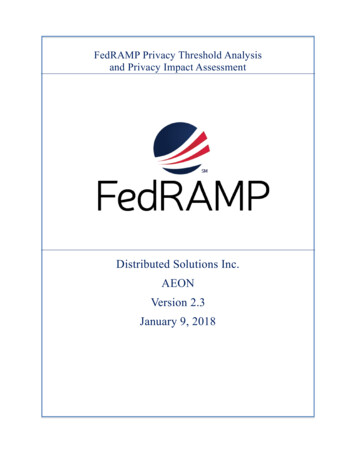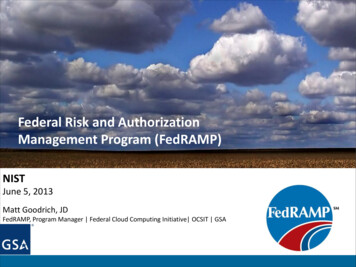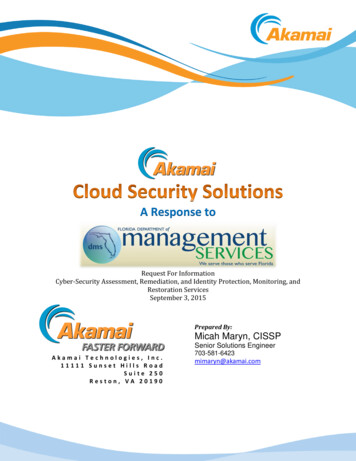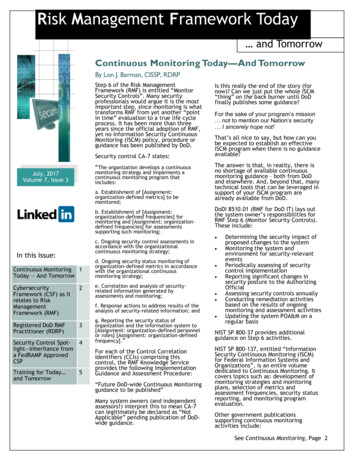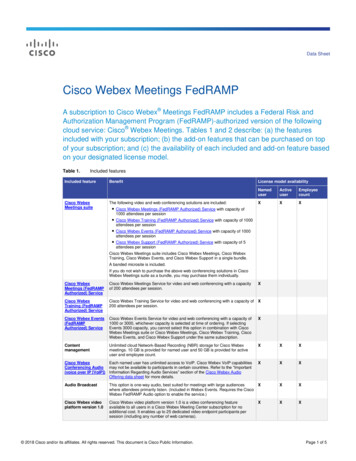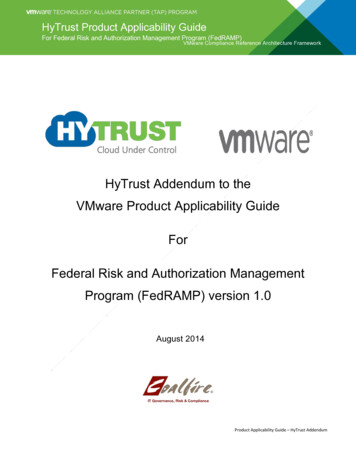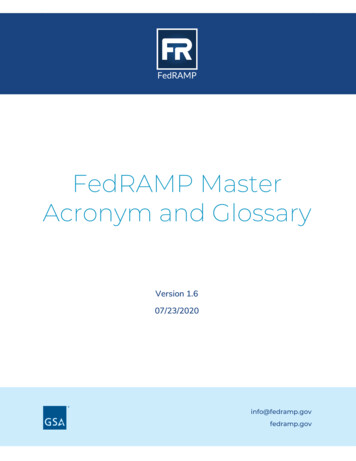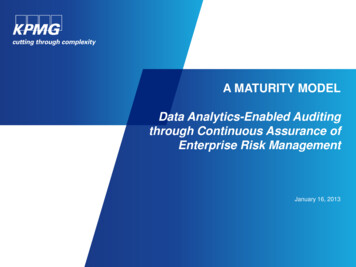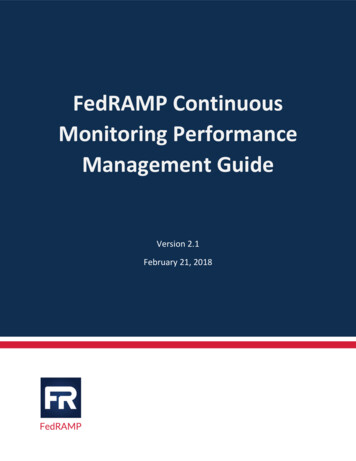
Transcription
FedRAMP ContinuousMonitoring PerformanceManagement GuideVersion 2.1February 21, 2018
DOCUMENT REVISION 151.0AllInitial documentFedRAMP PMO01/06/20161.16Added Formal CAP for second (or more) noncompliant delivery of scan results.FedRAMP PMO01/31/20182.0AllTitle change from FedRAMP P-ATO Managementand Revocation Guide to FedRAMP ContinuousMonitoring Performance Management Guide.FedRAMP PMO01/31/20182.0AllGeneral changes to grammar and use ofterminology to add clarity, as well as consistencywith other FedRAMP documents.FedRAMP PMO01/31/20182.02-5Added the Escalation Process and clarified theSuspension and Revocation Escalation Actions.FedRAMP PMO01/31/20182.06-8Clarified deficiency triggers.FedRAMP PMO01/31/20182.08Added a Zero-day Attack notification trigger.FedRAMP PMO01/31/20182.09Added Customer Demand threshold.FedRAMP PMO2/21/20182.18Updated links in Appendix A, which changed as aresult of migration of the FedRAMP web site.FedRAMP PMO2/21/20182.15For clarity, revised two entries in Table 1 relatedto late delivery of annual assessments.FedRAMP PMO i
ABOUT THIS DOCUMENTThis document provides guidance on continuous monitoring and ongoing authorization in support ofmaintaining a security authorization that meets the Federal Risk and Authorization ManagementProgram (FedRAMP) requirements.This document is not a FedRAMP template – there is nothing to fill out in this document.This document uses the term authorizing official (AO). For systems with a Joint Authorization Board (JAB)provisional authorization to operate (P-ATO), AO refers primarily to the JAB unless this documentexplicitly says Agency AO. For systems with a FedRAMP Agency authorization to operate (ATO), AOrefers to each leveraging Agency’s AO.WHO SHOULD USE THIS DOCUMENT?This document is intended to be used by Cloud Service Providers (CSPs), Third Party AssessorOrganizations (3PAOs), government contractors working on FedRAMP projects, and governmentemployees working on FedRAMP projects. This document may also prove useful for other organizationsthat are developing a continuous monitoring program.HOW TO CONTACT USQuestions about FedRAMP or this document should be directed to info@fedramp.gov.For more information about FedRAMP, visit the website at http://www.fedramp.gov. ii
TABLE OF CONTENTSDOCUMENT REVISION HISTORY. IABOUT THIS DOCUMENT . IIWHO SHOULD USE THIS DOCUMENT?. IIHOW TO CONTACT US . II1.INTRODUCTION .12.ESCALATION LEVELS AND PROCESS .23.CONMON REQUIREMENTS: RISK MANAGEMENT DEFICIENCY TRIGGERS .54.CUSTOMER DEMAND .7LIST OF FIGURESFigure 1. FedRAMP Escalation Process .2LIST OF TABLESTable 1. Risk Management Deficiency Triggers .5 iii
1. INTRODUCTIONThis document explains the actions FedRAMP takes when a CSP fails to maintain an adequatecontinuous monitoring capability. The FedRAMP continuous monitoring program is based on thecontinuous monitoring process described in the National Institute of Standards and Technology (NIST)Special Publication (SP) 800-137, Information Security Continuous Monitoring for Federal InformationSystems and Organization, and is governed by the FedRAMP Continuous Monitoring Strategy Guide.The goal is to provide: (i) operational visibility; (ii) managed change control; and (iii) attendance toincident response duties. Security-related information collected during continuous monitoring is used todetermine if the system security is operating as intended and in accordance with applicable Federal law,guidelines, and policies.When a CSP receives a P-ATO letter for its cloud system, that letter comes with the following minimumrequirements:1. CSP satisfies the requirement of implementing continuous monitoring activities as documentedin FedRAMP’s Continuous Monitoring (ConMon) Strategy Guide and CSP’s ContinuousMonitoring Plan;2. CSP mitigates all open Plan of Action and Milestones (POA&M) action items, agreed to in theSecurity Assessment Report (SAR), within the appropriate timeframe as defined in the agreedPOA&M; and3. CSP identifies and manages significant changes or critical vulnerabilities in accordance withapplicable Federal law, guidelines, and policies.Further, by accepting the P-ATO requirements, as outlined in the P-ATO letter1, the CSP agrees tomaintain Operational Visibility, Change Control, and Incident Response functions clearly defined in theFedRAMP Continuous Monitoring Strategy Guide. In addition, the CSP is expected to continue to followNIST SP 800-37, Revision 1, Guide for Applying the Risk Management Framework to Federal InformationSystems: a Security Life Cycle Approach, and the Risk Management Framework (RMF), continue toeffectively deploy all applicable security controls, and act in good faith to maintain the appropriate riskposture.Failure to adhere to the requirements of the P-ATO may result in escalation actions by FedRAMP, outlinedin subsequent sections of this document, as well as additional actions as FedRAMP deems appropriate.While this document specifically addresses FedRAMP P-ATOs maintained by the JAB, FedRAMPrecommends agencies create similar guides and/or use this FedRAMP Continuous MonitoringPerformance Management Guide when maintaining FedRAMP agency ATOs.1Additional requirements may be included in the P-ATO letter to address system-specific security concerns identified duringassessment. 1
2. ESCALATION LEVELS AND PROCESSAs a condition of the P-ATO, the CSP is agreeing to participate in the FedRAMP ConMon process. If theCSP fails to meet the requirements described in the FedRAMP Continuous Monitoring Strategy Guide,FedRAMP initiates an escalation process, which may result in one of the following escalation levels: Detailed Finding Review: A request from the FedRAMP Point of Contact (POC) for the CSP’ssecurity POC to assess a deficiency, and report the cause and remedy back to FedRAMP. If theCSP does not resolve a detailed finding review within the agreed upon timeframe, FedRAMPmay escalate to a corrective action plan. Corrective Action Plan (CAP): A request from the FedRAMP Director for the CSP’s system ownerto perform a root-cause analysis and provide a formal plan for remediation. If the CSP does notresolve a CAP within the agreed upon timeframe, FedRAMP may suspend or revoke the system’sP-ATO. Suspension: A decision by the JAB to temporarily suspend a system’s P-ATO until identifieddeficiencies are resolved. If the CSP does not resolve a suspension within the agreed upontimeframe, or if the FedRAMP Director and JAB determine the CSP can no longer meetFedRAMP compliance requirements, FedRAMP may revoke the system’s P-ATO. Revocation: A decision by the JAB to permanently revoke a system’s P-ATO. If revoked, the onlyway the system can obtain a P-ATO is by re-entering the JAB authorization process as if thesystem were seeking a P-ATO for the first time.When FedRAMP identifies a deficiency in the CSP’s ConMon capabilities, it initiates the process depictedin Figure 1. FedRAMP Escalation Process, below.Figure 1. FedRAMP Escalation Process1. FedRAMPIdentifiesConMonDeficiency2. FedRAMPReviewsDeficency3. FedRAMPNotifies CSPof Deficiency4. CSPProvidesRebuttal5. FedRAMPAdjudicatesResponse6. FedRAMPTakesAppropriateAction7. CSPProvidesResponseThe Escalation Process occurs as follows:1. FedRAMP identifies a deficiency with the CSP’s ConMon information.2. FedRAMP reviews the deficiency and compares it to the CSP’s past ConMon performance. As aresult of the review, FedRAMP decides on one of the following actions: FedRAMP typically decides on an escalation level consistent with the guidance described inSection 3, Common Requirements: Risk Management Deficiency Triggers. FedRAMP may elect to simply monitor the CSP more closely, but take no further action. If so,no notice is sent and the process stops here. FedRAMP may increase a CSP’s existing escalation level. For example, a CSP on a CAP mayface Suspension. 2
In rare cases, FedRAMP may determine the deficiency is severe enough to make theescalation effective immediately, in which case, steps #3 and 4 are skipped.3. FedRAMP notifies the CSP of the deficiency, and FedRAMP’s intended escalation. Dependingon the intended escalation level, the notice comes from: the FedRAMP POC for an intended detailed finding review; or the FedRAMP Director for an intended CAP, Suspension, or Revocation.4. The CSP responds to the notification. This CSP’s response should include any information thatmay rebut the escalation decision. Depending on the intended escalation level, the CSP’sresponse must come from: the CSP’s security POC for detailed finding review; or the CSP’s system owner for a CAP, Suspension, or Revocation.5. FedRAMP reviews and adjudicates the CSP’s response, and renders a formal escalationdecision. Depending on the escalation level, the decision is made by: the FedRAMP POC for a detailed finding review; the FedRAMP Director for a CAP; or the JAB for a Suspension or Revocation.6. FedRAMP notifies the CSP of its decision. If FedRAMP decides to follow through with anescalation, this notice: identifies the criteria for returning the system to a “Satisfactory” status. It may also includea deadline by which the CSP must fully satisfy the criteria or face more severe escalation;and requires certain actions from the CSP. Typically FedRAMP requires the CSP to perform aroot-cause analysis and develop a formal plan for addressing the deficiencies.7. CSP responds in accordance with the FedRAMP notification. This response must include: the results of the root cause analysis; the CSP’s plan for fully resolving the issues, with clearly established milestones and dates,including a date of full resolution. For a CAP or Suspension, the plan must be signed by thesystem owner. FedRAMP must approve the plan; and any other items as specified by FedRAMP in its notification.When a CSP is subject to escalation as described above, the following occurs: Monthly ConMon Reporting to Leveraging Agencies: FedRAMP updates the next monthlyreport to reflect the cited deficiencies, escalation level, and the CSP’s identified resolutiondate.The system’s status is changed to “Minor Concern” for a detailed finding review, or “MajorConcern” for a CAP or Suspension. The status remains and the CSPs progress is reportedeach month until FedRAMP determines the issue is fully resolved.FedRAMP discontinues ConMon reporting when the system’s P-ATO is suspended orrevoked. 3
Other Postings and Notifications to Leveraging Agencies: If there is a CAP, Suspension, orRevocation, a letter is posted to OMB MAX for review by leveraging agencies, as is the CSP’splan for resolution where appropriate. The information is retained indefinitely for historicalreference.If a system’s P-ATO is suspended or revoked, FedRAMP will directly notify each knownleveraging agency, and will require the CSP to ensure the known leveraging agencies matchthe CSP’s customer list for the impacted system.NOTE: P-ATO Revocation does not automatically result in revocation of each leveragingagency’s ATO. Each leveraging agency’s AO reviews the circumstances of P-ATO Revocation,and makes a determination regarding the status of the ATO they issued the system onbehalf of their agency. FedRAMP Marketplace: FedRAMP updates the system’s status on the FedRAMPMarketplace to reflect the escalation level for Suspension. FedRAMP removes the systemfrom the Marketplace if the P-ATO is revoked. Detailed finding review and CAPs are notreflected on the Marketplace. Further Escalation: If the CSP fails to provide a plan acceptable to FedRAMP, or fails to meetthe dates identified in the plan, FedRAMP may increase the escalation level. Furtherescalation repeats the same escalation process described above. Extension: If the CSP has made good-faith efforts to fully resolve the deficiency and addressthe plan, but requires more time, they may request an extension from FedRAMP.When FedRAMP determines the CSP has fully resolved the cited deficiencies and satisfied the FedRAMPidentified criteria communicated in the notification, FedRAMP takes the following actions: Notification to CSP: The FedRAMP POC notifies the CSP’s security POC when FedRAMPagrees a detailed finding review is fully satisfied. The FedRAMP Director notifies the systemowner when FedRAMP agrees a CAP or Suspension is fully satisfied. Monthly ConMon Reporting to Leveraging Agencies: FedRAMP updates the next monthlyreport to reflect all cited deficiencies are resolved and the escalation level is no longer ineffect. The status is returned to “Satisfactory.” Other Postings and Notifications to Leveraging Agencies: The FedRAMP Director posts aletter to the secure repository indicating the CAP or Suspension is fully resolved toFedRAMP’s satisfaction and the CSP is once again in good standing. As no letter is postedwhen a detailed finding review is initiated, no letter is posted when it is resolved. FedRAMP Marketplace: FedRAMP returns the system’s status to its normal listing with noindication of an escalation level. 4
3. CONMON REQUIREMENTS: RISK MANAGEMENT DEFICIENCY TRIGGERSTo ensure consistent expectations and enforcement, FedRAMP defines risk management deficiency“triggers.” When a CSP’s performance exceeds one or more of the thresholds defined in Table 1. RiskManagement Deficiency Triggers, below, FedRAMP will, at a minimum, take the prescribed action.Table 1. Risk Management Deficiency TriggersCONMONPROCESSAREARISK MANAGEMENT DEFICIENCY TRIGGEROperationalVisibilityUnique Vulnerability Count Increase20% from P-ATO baseline (or 10 unique vulnerabilities whichever is greater)Note: A request for rebaseline of a unique vulnerability count, accompanied withproper justification, can be submitted to FedRAMP and may be approved on a caseby case basis.Non Compliance with scanning requirements outlined in the FedRAMP JABP-ATO Vulnerability Scan Requirements Guide (available on FedRAMP.gov)First incident in the previous six months.Unauthenticated scan results delivered as part of the initial SAR submission, aspart of the annual SAR submission, or as part of the monthly scanning submission,where the unauthenticated scans are 10% or greater of the total scan submission,result in the CSP being placed on a Detailed Finding Review. This applies only to afirst CSP submission that is non-compliant with authenticated scan requirements.Non-Compliance with scanning requirements outlined in the FedRAMP JABP-ATO Vulnerability Scan Requirements Guide (available on FedRAMP.gov)Each subsequent incident beyond the first within the previous six months.Unauthenticated scan results delivered as part of the initial SAR submission, aspart of the annual SAR submission, or as part of the monthly scanning submission,where the unauthenticated scans are 10% or greater of the total scan submission,result in the CSP being placed on a CAP, when a second or greater CSP submissionis non-adherent to authenticated scan requirements.Late Remediation High Impact VulnerabilitiesFive or more unique vulnerabilities or POA&Ms aged greater than 30 daysLate Remediation High Impact VulnerabilitiesFive or more unique vulnerabilities or POA&Ms aged greater than 60 daysLate Remediation Moderate Impact VulnerabilitiesTen or more unique vulnerabilities or POA&Ms aged greater than 90 daysLate Remediation Moderate Impact VulnerabilitiesTen or more unique vulnerabilities or POA&Ms aged greater than 120 daysLate Delivery of Annual Assessment SAPDelivery of Annual Assessment SAP less than 60 days before annual P-ATO dateLate Delivery of Annual Assessment PackageDelivery of full Annual Assessment P-ATO Package after P-ATO anniversary dateMINIMUMESCALATIONLEVELDetailedFinding ReviewDetailedFinding ReviewCAPDetailedFinding ReviewCAPDetailedFinding ReviewCAPCAPCAP 5
hangeControlIncidentResponseRISK MANAGEMENT DEFICIENCY TRIGGERPoor Quality of DeliverablesUntimely or inaccurate submission of any deliverable, including (but not limitedto) monthly ConMon documents, Deviation Requests, or Significant ChangeRequestsLack of TransparencyFailure to report known issues to FedRAMP or purposely manipulating scans toavoid Risk Management TriggersMultiple RecurrencesAny trigger that is realized multiple times within a 6-month timeframeInsufficient Notice of Planned ChangeNotification received less than 30 days before the planned change or insufficientdocumentation of the Security Impact AnalysisLate Notice of Emergency ChangeNotification received longer than five days after the changeUndocumented/Unreported ChangeNo notificationDegradation of the Change Management and Change Control ProcessesInsufficient adherence to the provided Configuration Management Plan asdetermined by FedRAMPLate Incident NotificationLate notification of incident not in accordance with the FedRAMP IncidentCommunications Procedure and United States Computer Emergency ReadinessTeam (US-CERT) Federal Incident Notification GuidelinesNote: An incident is a violation of computer security policies, acceptable usepolicies, or standard computer security practices, according to NIST SpecialPublication 800-61, Computer Security Incident Handling Guide, Revision 2.Incident Frequency of Recurring TypeAny incident with recurring type and/or causeIncident FrequencyFour or more incidents within six monthsTimely and Ongoing Notification of Zero Day AttackFailure to provide to FedRAMP daily updated progress in addressing Zero DayAttacksMINIMUMESCALATIONLEVELDetailedFinding ReviewCAPCAPCAPCAPCAPDetailedFinding ReviewCAPCAPDetailedFinding ReviewCAP 6
4. CUSTOMER DEMANDTo remain eligible for a JAB P-ATO, FedRAMP requires a minimum of six unique agency customers withauthorizations2 that leverage the system’s JAB P-ATO. FedRAMP evaluates CSP demand on a quarterlybasis to ensure CSPs with P-ATOs are meeting and maintaining program demand thresholds.A CSP that has fewer than six unique Federal Information Security Management Act (FISMA) SystemATOs posted on the FedRAMP Secure Repository will be placed on a CAP at the discretion of theFedRAMP Program Management Office (PMO) and JAB. A CSP that cannot meet or maintain thisdemand threshold has the opportunity to pursue FedRAMP Agency Authorizations, in lieu of the P-ATO,with the support of the FedRAMP PMO.FedRAMP established this threshold based on JAB resources, to ensure JAB continuous monitoringresources are focused on systems that result in broader impact across the Federal Government.FedRAMP may adjust this threshold at its discretion due to changes in available resources and overalldemand across the Federal Government for cloud services.2The FedRAMP PMO does not count the Defense Information Systems Agency (DISA) P-ATO as part of the unique agencycustomer total because it does not represent a true unique agency customer authorized to use a CSO. 7
APPENDIX A: FEDRAMP ACRONYMSThe FedRAMP Master Acronyms & Glossary contains definitions for all FedRAMP publications, and isavailable on the FedRAMP website Documents page under Program Overview se send suggestions about corrections, additions, or deletions to info@fedramp.gov. 8
Title change from FedRAMP P-ATO Management and Revocation Guide to FedRAMP Continuous Monitoring Performance Management Guide. FedRAMP PMO 01/31/2018 2.0 All General changes to grammar and use of terminology to add clarity, as well as consistency with other FedRAMP documents. FedRAMP PMO 01/31/2018 2.0 2-5

